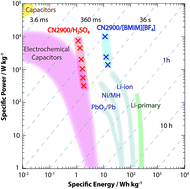Bridging the performance gap between electric double-layer capacitors and batteries with high-energy/high-power carbon nanotube-based electrodes†
Abstract
Electric double-layer capacitors (EDLCs) store electrical energy at the interface between charged electrodes and electrolytes and are higher-power devices than batteries. However, the amount of energy stored in EDLCs cannot compete with that in batteries. In this contribution, we describe the development of new EDLCs that can store about as much energy as lead–acid and nickel metal hydride (NiMH) batteries but operate at much higher power densities than those achievable using batteries. The electrode materials are derived from carbon nanotubes (CNTs) synthesised from CCl4 and ferrocene at 180 °C, which is drastically lower than the temperatures usually used to synthesise CNTs. By chemically activating the CNTs using KOH, Brunauer–Emmett–Teller (BET) surface areas reach ∼3000 m2 g−1, which is orders of magnitude higher than those typical of CNTs, and exceeds even that of pristine graphene. Gas sorption analysis shows that the samples activated at 900 °C contain a mix of micropores and small mesopores, while the samples activated at lower temperatures are predominantly microporous. In EDLCs containing aqueous H2SO4 as the electrolyte, the mesoporous carbons exhibit mass-specific capacitances up to 172 F g−1, while in the presence of the ionic liquids 1-ethyl-3-methylimidazolium tetrafluoroborate, [EMIM][BF4], and 1-butyl-3-methylimidazolium tetrafluoroborate, [BMIM][BF4], capacitances up to 150 F g−1 are measured. Due to the wide potential window of the ionic liquid electrolytes and the unique morphology of the electrode materials, 3 V devices with volume-specific energy densities of the order of 6 W h L−1 and mass-specific energy densities up to about 15 W h kg−1 can be fabricated. The energy stored can be delivered at power densities >1 kW kg−1 meaning that the performance of these devices bridges the performance gap between those of EDLCs and batteries. The use of this novel electrode material not only allows the fabrication of high-energy/high-power energy storage systems, but also the methods used to fabricate the electrode materials are inexpensive and can readily be scaled to industrial levels.

- This article is part of the themed collection: 2016 Journal of Materials Chemistry A HOT Papers


 Please wait while we load your content...
Please wait while we load your content...